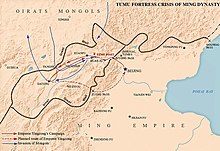This article needs additional citations for verification. (August 2020) |
40°23′N 115°36′E / 40.383°N 115.600°E
| Crisis of the Tumu Fortress | |||||||
|---|---|---|---|---|---|---|---|
 | |||||||
| |||||||
| Belligerents | |||||||
| Northern Yuan, Oirat Mongols | Ming dynasty | ||||||
| Commanders and leaders | |||||||
| |||||||
| Strength | |||||||
| 20,000 | 500,000[1] (thought to be an inflated figure)[2] | ||||||
| Casualties and losses | |||||||
| 2,000 | 400,000 | ||||||
The Crisis of the Tumu Fortress (simplified Chinese: 土木堡之变; traditional Chinese: 土木堡之變), also known as the Tumu Crisis (simplified Chinese: 土木之变; traditional Chinese: 土木之變; Mongolian: Тумугийн тулалдаан), or the Jisi Incident (simplified Chinese: 己巳之变; traditional Chinese: 己巳之變), was a frontier conflict between the Northern Yuan and Ming dynasties. The Oirat ruler of the Northern Yuan, Esen, captured the Emperor Yingzong of Ming on September 1, 1449.[1]
- ^ a b Nolan, Cathal J. The Age of Wars of Religion, 1000–1650, Volume 1: An Encyclopedia of Global Warfare and Civilization Greenwood Press (2006) ISBN 978-0-313-33733-8 p. 151 [1]
- ^ Rossabi, Morris (1998). "The Ming and Inner Asia". The Cambridge History of China, Volume 8: The Ming Dynasty, 1368–1644, Part 2. Cambridge: Cambridge University Press. p. 228. ISBN 0-521-24333-5.